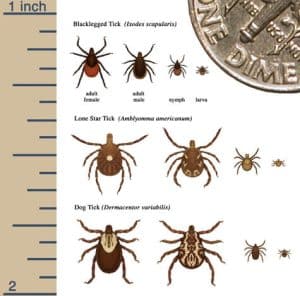Lyme Disease Prevention Guidelines 2018
 KFL&A Public Health reports that in 2013, 23% of the ticks brought in for testing were positive for B. Burgdorferi, the infectious agent of Lyme Disease. In 2016, this number rose to 32%. And though only 1 to 4% of bites from infected ticks generate infection, the rate is plenty high enough to consider our region a Lyme-endemic location. Please educate yourself, friends, and family members about tick-bite prevention and treatment. I’ve thoroughly researched and summarized some guidelines to keep in mind this season:
KFL&A Public Health reports that in 2013, 23% of the ticks brought in for testing were positive for B. Burgdorferi, the infectious agent of Lyme Disease. In 2016, this number rose to 32%. And though only 1 to 4% of bites from infected ticks generate infection, the rate is plenty high enough to consider our region a Lyme-endemic location. Please educate yourself, friends, and family members about tick-bite prevention and treatment. I’ve thoroughly researched and summarized some guidelines to keep in mind this season:
- Wear light-coloured, long-sleeved clothing with pants tucked into socks, when outdoors in tall grasses and wooded areas so that ticks are more visible.
- A product containing 30% DEET is officially recommended for adults. For children younger than 12 years, Health Canada recommends using a product with 10% DEET. However, the repelling effects at this concentration may only last for 1 to 2 hours. Alternate approved chemicals for children or sensitive individuals include products with Icaridin (e.g. Avon Skin So Soft, some MEC and OFF! brand products).
- Non-approved but well researched natural repellants include Lemon Eucalyptus oil (Eucalyptus citriodora), Labrador tea oil (Rhododendron tomentosum), Juniper (Juniperus virginia), and Marjoram (Origanum majorana). These can be mixed in a ratio of 12 parts pure grain alcohol (95% if available), to 1 part oil combination, and applied liberally with a spritzer bottle (preferably brown glass) over (Do not apply concentrated essential oils to the skin directly.)
- Spraying pesticides around your home might help control tick populations, but at least 2 studies suggest that this makes no difference in your risk of becoming infected. It can also negatively impact your immune system and the health of our environment.
- Do not apply sunscreen and insect repellent together. It reduces their effectiveness and/or can increase the skin’s absorption of harmful chemicals.
- Do tick checks every time you come in from outside. Be sure to check pets and children’s toys (e.g. blankets). Some people find that going over their clothing with a lint roller is helpful, or taking a shower to wash off unattached ticks. Be particularly wary of the tiny nymphs (1 to 2mm) that come out in late Spring and during sudden winter thaws.
- If you find a tick attached to your skin, gently and slowly remove it straight out with a pair of tweezers, by the head and as close to the skin as possible without squeezing or twisting its body. Some people find that the “Tick Twister” removal device is easier to use than the “Tick Key”, in areas such as behind the ears.
- KFL&A public health no longer accepts ticks for testing. Take note of the kind of tick it is (the blacklegged tick is the most common but not only carrier of disease-causing bacteria), before disposing of it.
- Apply an anti-septic to the bite area. Additionally applying a glob of bentonite clay to the area for 12 to 24 hours may help to prevent infection.
- Take a photo of the bite area to help you recall the location of the bite and date, should a rash or other symptom appear in the future. (Don’t rely on the appearance of a rash for a diagnosis. It’s likely that as few as 30% of people with an infection develop a rash.)
- Public Health advises that infection will not occur if you remove the tick within 24 hours. This is likely true for the agent that causes Lyme disease, but it is unlikely true for some of the co-infections. Researchers have identified at least 15 bacteria that commonly accompany the Lyme bacteria in the gut of the tick, and this list grows by the year. Please treat every tick bite regardless of how long the tick was attached. This means that you know when to use antibiotics, when to use botanicals, and how to use diet and lifestyle to best support your immune system. (This is where your Naturopathic Doctor comes in handy!)
- If you did contract the Lyme bacteria, testing won’t be positive for at least 2-6 weeks. Further, technology available for testing is inadequate, missing a proper diagnosis in up to 2/3rds of cases. Shifting our focus away from the bacteria, and onto our immune system, is the best way to prevent and treat infection.
- Stephen Buhner is an herbalist and expert in Lyme disease treatment. He recommends that people living in endemic regions supplement with 1000mg of Astragalus daily during the tick season.
Tick Bite Kit:
|
When to Consider Pharmaceutical Antibiotics:
- Any summer flu symptoms, such as headache and muscle pain (whether you recall a tick bite or not);
- A known tick bite with a subsequent rash (take a photo);
- A tick bite and you have reason to believe that your immune system is compromised;
- You already use immunosuppressive medications such as steroids (e.g. for autoimmune disease);
- A tick bite and you have a pre-existing neurological illness, such as Multiple Sclerosis.
When to Consider Botanicals:
Always! These work well with antibiotics (i.e. they support the immune system’s clean-up after the antibiotic reduces the bacterial load), and are our best way to defend ourselves against infections, alongside diet and lifestyle. We have various protocols for before and after tick bites, according to the symptoms you develop and where your immune system requires the most support.
Lyme disease, Naturopathic medicine